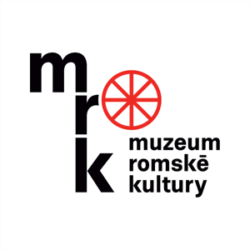Božena Valdová
Božena Valdová, née Heráková, born 1929 in Komňa, Uherské Hradiště district
-
Testimony abstract
Božena Valdová grew up in Žeranovice as an only child, since her twin brother died when he was about nine months old. The family lived in a house together with her father's younger brother, his wife and their three children. Their house, which was next door to another brother's house, was built by the two men with their own hands. Her father's name was Herák[1] and he was a horse trader.
- [1] First name not given.
When, as she said, it was about to happen [meaning the arrests and transports], they fled to Lidečko in Moravian Wallachia, where they hid in someone’s home,[1] and later in the forest. The local gendarmes knew about them but left them alone. It was only when the Heráks were denounced – allegedly by a Romani man originally from Žeranovice – that the gendarmes took them to police headquarters in Brno on the basis of an arrest warrant, and from there, after about a month, to “Hodonínek”. She went to work with her parents, breaking stones into gravel, and she says that the conditions there were less severe than in Auschwitz, to which the family was deported in August.[2] They were taken by passenger train and in Ostrava, where there was a stop, the gendarmes repeatedly tried to persuade her to go for water. She thought they wanted her to escape and save herself, but she had no intention of abandoning her parents, so she preferred not to fetch water in order not to miss the train.
After arriving at Auschwitz, they went on foot to the camp, where an SS man spoke to them in the assembly area. She said the block chief (Blokalteste), who did not want them not to make any noise, inadvertently slapped her on the leg with a lath which had a nail in it; it pierced her leg, and although her father immediately sucked the wound clean, she still had a scar there.
When clothes and underwear were issued,[3] they were ugly and stained, so she said she would not wear them. She now realised she could have endangered her parents, but the SS officer who was called in found it amusing that it was a child and not the adults who had rebelled, and ordered cleaner underwear and clothes to be selected for her.
Among the reception procedures, she mentioned the tattooing of prison numbers and the humiliating mass bath, where men, women and children had to strip naked and shower together. Their hair was already cut from Hodonín, and only the heads of those whose hair had grown or who were lice-ridden were shaved.
The family was placed in block number 10, which was still being completed. A kind of chimney stretched along the ground in the middle of the barracks, which heated both sides, and the prisoners slept on three-storey bunk beds under rough, coloured blankets. Lice and scabies plagued them because of their lack of hygiene. Their block chief,[4] whose personal barber was Valdová's father, was very cruel. He had his own room in the block, in which his mistress, nicknamed Lači (meaning “good” in Romani), lived with him. She was not, however, a good person; for example, she beat Valdová's mother, who was in an advanced stage of pregnancy, for repeatedly giving a little boy a bit extra when she was sharing out food.[5] Then, while digging the sewers, they accidentally discovered the hiding place in which the block chief had hidden his gold, and he ended up in the penal camp,[6] where he died.
The water in the camp was not drinkable, and the prisoners were at risk of dysentery, so they drank "a kind of unsweetened, bitter kind of strange tea," and with it they were given bread made with shavings [i.e., sawdust]. In the evening they sometimes had a slice of salami or a piece of margarine with their bread. If some days they didn't work, they also received a lunch of boiled beets. The German Roma, who slept on bunk beds at the entrance to the block, used to get double the rations of the other prisoners; Valdová's father with several other men protested against this, but the block chief beat them. So many people died of dysentery and other diseases that four wagons of bodies were taken from their camp to the crematoria every day; among them were Božena Valdová’s grandparents.
After breakfast, the prisoners went to work. The women mostly repaired the roads and carried sand and other materials, while the men’s jobs included sorting the Jews' belongings into piles on the days when the transports arrived.[7] At first the mothers of young children stayed with them in the block; later the children were in a kind of kindergarten and their mothers had to go to work as well.
Božena Valdová fell ill twice in the camp. When she got scabies, they put her in the sick bay where she had to lie naked and smeared with ointment wrapped only in a blanket. Then she got sick again, and had chills, which her mother cured her of by wrapping her up. One night, when she went to the end of the barrack where the barrels used as toilets were located, she saw a girl of about sixteen hanging there upside down, suspended by her arms.[8] She also recalled how shaken she was when a block chief brutally beat a little boy in front of his mother simply because he was crying and could not be quieted.
Božena Valdová left Auschwitz by transport to Ravensbrück. On the same day, her father was sent to Buchenwald.[9] Her mother, who had unexpectedly became pregnant after fourteen years, gave birth to a baby girl in the camp who was only a few weeks old when the transports separated the family. She and her baby died in the camp.
One day a load of heavy crates overturned on Valdová in Ravensbrück and she was taken unconscious to the infirmary, where she was cared for by a nurse who spoke Czech. She recalled that the prisoners there were promised that they would be freed if they agreed to be experimented on. Instead, they all died. She was spared, probably because she was young.
She was deported from Ravensbrück to a camp near Hamburg,[10] from which they were taken to clear the debris after the bombing. A Polish cellmate overheard the Germans saying that the Americans were already in Hamburg; that woman managed to escape and send the Americans to the camp to help. When the Germans discovered that she had escaped, they locked the prisoners in the blocks and fled in a hurry, so that the women did not even notice that they had been unattended for almost a day and a half. Then, after they were freed, they wept and fainted with happiness and joy.
- [1] Name not remembered.
- [2] Transport on 22 August 1943. (ed.)
- [3] The gypsy camp prisoners remained in civilian clothes, on which they had crosses painted in red paint across their backs in the shape of the letter X. (ed.)
- [4] Paul Wegener, a German Romany, was the block chief. (ed.)
- [5] Paul Wegener's mistress and deputy, real name Wanda, set up a brothel in the SS block. (ed.)
- [6] In fact, the penal work division (Strafkompanie). (ed.)
- [7] Aufräumungskommando, called “Canada” in prison parlance. (ed.)
- [8] A punishment in which the victim was hung by a rope or chain by his twisted arms from a ceiling beam so that he could not reach the floor with his feet (Pfahlbinden). (ed.)
- [9] Transports on 2 August 1944. (ed.)
- [10] Most likely the Neuengamme concentration camp near Hamburg, which was liberated by Allied troops on 5 May 1945. (ed.)
Božena Valdová returned home a month before her father. Not long after the war, she went to the cinema to see a film about Auschwitz, but she said it was a fairy tale that had nothing to do with reality. But the audience cried, so when she started laughing provocatively during the screening, they called an usher to show her out. Outside, she explained to him why she had laughed, after which he apologized profusely.
How to cite abstract
Abstract of testimony from: NEČAS, Ctibor, ed. Nemůžeme zapomenout = Našťi bisteras : nucená táborová koncentrace ve vyprávěních romských pamětníků. Olomouc: Univerzita Palackého, 1994. ISBN 80-7067-354-0, 217-224. Testimonies of the Roma and Sinti. Project of the Prague Forum for Romani Histories, https://www.romatestimonies.com/testimony/bozena-valdova (accessed 10/25/2025) -
Origin of Testimony
The tape recording and transcript of the memoir were made by Ctibor Nečas on 6 February 1988.
-
Where to find this testimony




